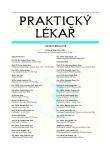-
Medical journals
- Career
Incidence of pulmonary embolism in females aged 15–25 years in relation to oral contraception use (Results of a five-year study)
Authors: D. Chroustová 1; K. Krátká 2; D. Palyzová 4; R. Petr 3
Authors‘ workplace: Klinika nukleární medicíny FNKV a 3. LF UK, Praha Přednosta: MUDr. Otto Lang, Ph. D. 1; I. interní klinika FNKV a 3. LF UK, Praha Přednosta: prof. MUDr. Jiří Horák, CSc. 2; III. interní klinika FNKV a 3. LF UK, Praha Přednosta: prof. MUDr. Petr Widimský, DrSc. 3; Klinika dětí a dorostu FNKV a 3. LF UK, Praha Přednosta: doc. MUDr. Felix Votava, Ph. D. 4
Published in: Prakt. Lék. 2009; 89(8): 439-443
Category: Of different specialties
Overview
Aim:
The aim of the present study was to analyse patients, aged 15–25 years, who were examined with a view of pulmonary embolism (PE) suspicion in relation to oral contraception (OC) use in our department during a five-year period (2003-2008).Material and methods:
The patient sample includes 134 females aged 15–25 (average 21 years) who were indicated to lung perfusion scintigraphy. Radionuclide phlebography was done in 25 girls with suspicion of thrombosis of lower limb deep venous system (DVS). Lung scintigraphy was performed using a planar/SPECT camera in 4/8 projections following 150 MBq 99mTc -MAA i.v. application. Radionuclide phlebography was performed using a 2-detector camera registering calf DVS blockage data on the dynamic study and followed by whole body lower limb images with and without leg tourniquets. For analytical purposes, the patients were divided into 3 groups:
group I – suspect PE without any additional diagnosis;
group II – suspect PE as a complication of a surgery or trauma;group III – others.
Results:
1) Signs of PE were found in 23/116 patients in group I, 5/15 patients in group II, and 1/3 patients in group III.
2) DVS blockage of lower limbs was detected in 5/15 patients in group I, in 3/4 patients in group II and no radionuclide phlebography was indicated in group III.
3) Of the 89/134 (66%) patients who were using OC, 28 % had PE.
4) Among the 45 females not using OC, PE was detected in 4 patients (9 %).
5) Radionuclide phlebography was indicated in 24 patients using OC, 5 of whom were found to have DVS blockage of lower limbs.Conclusion:
In our group of patients, who were indicated to lung scintigraphy, the majority were using OC, 28 % of whom were diagnosed with PE on scintigraphy, compared to those not using OC with only 9 % of PE. Risk of venous thromboembolism related to the use of OC is well known. Our study indicates that it needs to be considered as a cause of PE even among very young females.Key words:
venous thromboembolism, lung perfusion scintigraphy, radionuclide phlebography, oral contraception, young age.
Sources
1. Dulíček, P., Kalousek, I., Malý, J. Hormonální antikoncepce a tromboembolická nemoc - jak je to ve skutečnosti. Interní medicína, 2002, 4, 8, s. 4-8.
2. Farmer, R.D., Lawrenson, R.A., Thompson, C.R, et al. Population-based study of risk of venous tromboembolism associated with various oral contraceptives. Lancet 1997, 349, p. 83-88.
3. Kaper, R.F., Norpoth, T., Rekers, H. Third - and second-generation oral contraceptives are associated with similar risk estimates for venous thromboembolism. Eur. J. Contracept. Reprod. Health Care 2002, 5, 1, p. 1-15.
4. Liu, X.Y., Babit, T.G., Bang, N.U. Combined heterozygosity of factor V Leden and the G20210A protrombin gene mutation in the patient with cerebral cortical vein trombosis. Am. J. Hematology 2000, 64, p. 226-228.
5. Roušová, E., Hadačová, I., Macek, M. Hereditární trombofilie - jeden z modelů molekulární medicíny. Klin. Biochem. Metab. 2005, 13, 2, s. 68-76.
6. Stein, P.D., Kayali, F., Olsin, R.E. Trends in the use of diagnostic imaging in patiens hospitalized with acute pulmonary embolism. Am. J. Cardiol. 2004, 93, p. 1316-1317.
7. Westgate, E.J., FitzGerald, G.A. Pulmonary embolism in woman taking oral contraceptives and valdecoxib. Plos. medicine 2005, 2(7), p. 619-620.
Labels
General practitioner for children and adolescents General practitioner for adults
Article was published inGeneral Practitioner

2009 Issue 8-
All articles in this issue
- Current news in occupational preventive health care services
- Primary prevention of the late effects of genotoxic and carcinogenic xenobiotics
- Prostate cancer in the age of the da Vinci robotic radical prostatectomy
- Risks of falls in patients with diabetes
- Analysis of quarterly occurrence of selected types of congenital malformations in the Czech Republic in 1994–2008
- Incidence of pulmonary embolism in females aged 15–25 years in relation to oral contraception use (Results of a five-year study)
- Bedside assessment: urodynamic examination at a patient’s bedside
- Addictive disease and money – relevant connections
- The calcium score: helper or a bad counsellor in diagnostics of chest pain suspected of coronary origin
- Prevention of venous thrombosis (phlebothromboprophylaxis) in clinical practice
- General Practitioner
- Journal archive
- Current issue
- Online only
- About the journal
Most read in this issue- The calcium score: helper or a bad counsellor in diagnostics of chest pain suspected of coronary origin
- Prostate cancer in the age of the da Vinci robotic radical prostatectomy
- Incidence of pulmonary embolism in females aged 15–25 years in relation to oral contraception use (Results of a five-year study)
- Prevention of venous thrombosis (phlebothromboprophylaxis) in clinical practice
Login#ADS_BOTTOM_SCRIPTS#Forgotten passwordEnter the email address that you registered with. We will send you instructions on how to set a new password.
- Career

